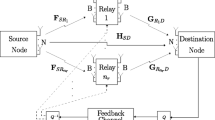Abstract
The delay elements of a conventional two-dimensional space–time receiver are fixed. The rather inflexible design is inappropriate since the received signals among the antenna branches are correlated due to limited spacing, and the fading environment is time-varying. In this paper we propose a dynamic finger assignment strategy for a space–time receiver, where the delay taps are adjusted dynamically, based on the theory of finite projective planes, to improve the signal-to-noise ratio in correlated antenna branches. The proposed finite projective plane (FPP) based finger assignment scheme maximizes the collected energy by dynamically setting the tap delays depending on the correlation among antenna branches and the delay spread of the channel. In the performance evaluation, we demonstrate that the FPP based finger assignment scheme can improve the signal-to-noise ratio significantly in comparison to the conventional mesh-grid configuration when the correlation among antenna branches is high and the channel dispersion is relatively long in comparison to the overall span of the fingers. However, the gain is moderate if the channel dispersion ratio is short, where the gain of reduced correlation among antenna branches must compensate for the reduced signal-to-noise ratio due to the missed signals.
Similar content being viewed by others
References
Paulraj, A., Khalaj, B., & Kailath, T. (1994). 2D RAKE receivers for CDMA cellular systems. In Proceedings of IEEE GLOBECOM, Vol. 1, San Francisco, pp. 400–404, CA, Dec. 1994.
Fang, M., Wang, J., Gong, K., & Tao, Y. (1999). Optimal 2D-RAKE receiver for coherent DS-CDMA in multipath. IEEE Vehicular Technology Conference, VTC, 1, 181–185, Fall.
Huang, K., Wang, J., & Wang, Y. (2003). Performance analysis of equal gain combining 2D RAKE receiver in NAKAGAMI-fading channels. IEEE Vehicular Technology Conference, VTC Spring, Vol. 4, pp. 2579–2583.
Win M.Z., Scholtz R.A. (2000). Ultra-wide bandwidth time-hopping impulse radio for wireless multiple-access communications. IEEE Transactions Communications 48(4): 679–691
Win M.Z., Scholtz R.A. (1998). Impulse radio: How it works. IEEE Communications Letters 2, 36–38
Win, M. Z., & Scholtz, R. A. (1997). Comparisons of analog and digital impulse radio for multiple -access communications. Proceedings of IEEE International Conference on Communications, Vol. 1, pp. 91–95, Montr’eal, CANADA.
Win M.Z., Kostic Z.A. (1999). Virtual path analysis of selective RAKE receiver in dense multipath channels. IEEE Communications Letters 3, 308–310
Win M.Z., Chrisikos G., Sollenberger N.R. (2000). Performance of RAKE reception in dense multi-path channels: Implications of spreading bandwidth and selection diversity order. IEEE Journal on Selected Areas in Communications 18, 1516–1525
Win, M. Z., & Chrisikos, G. (2001). Impact of spreading bandwidth and selection diversity order on selective RAKE reception. In A. F. Molisch (Ed.), Wideband wireless digital communications (pp. 424–454). Upper Saddle River: Prentice Hall.
Cassioli, D., Win, M. Z., Vatalaro, F., & Molisch, A. F. (2002). Performance of selective RAKE reception in a realistic UWB channel. In Proceedings of IEEE International Conference on Communications, Vol. 2, pp. 763–767, May 2002. New York, NY.
Mun, C., Kang, C.-H., Kim, S. K., & Park, H.-K. (1999). Performance of 2D-RAKE receiver in an arbitrarily correlated frequency-selective Nakagami fading. IEEE Vehicular Technology Conference, 1999. VTC 1999 - Fall. IEEE VTS 50th, Vol. 4, pp. 2173–2177, Sept. 1999.
Foschini. G. J. (1996). Layered space–time architecture for wireless communications in fading environments when using multi-element antennas. Bell Labs Technical Journal, pp. 41–59.
Winters J. (1987). On the capacity of radio communications systems with diversity in a Rayleigh fading environment. IEEE Journal on Selected Areas in Communications 5, 871–878
Goldsmith A., Jafar S.A., Jindal N., Vishwanath S. (2003). Capacity limits of MIMO Channels. IEEE Journal on Selected Areas in Communications 21(5): 684–701
Lee, W. C. Y. (1982). Mobile communications engineering. New York: McGraw Hill, Chapter 10, p. 308.
Lee W.C.Y. (1973). Effects of correlation between two mobile radio base station Antennas. IEEE Transactions on Communications 21, 1214–1224
Albert A., Sandler R. (1968). An introduction to finite projective planes. New York, Holt
Klein, A. (1997). Data detection algorithms specially designed for the downlink of CDMA mobile radio. In Proceedings of IEEE Vehicular Technology Conference (VTC), pp. 203–207.
Ghosh, M. (2001). Adaptive chip-equalizers for synchronous DS-CDMA systems with pilot sequences. In Proceedings of IEEE Global Telecomm Conference (GLOBCOM), pp. 3385–3389.
Petre, F., et al. (2001). Space-time chip equalizer receivers for WCDMA forward link with time-multiplexed pilot. In Proceedings of IEEE Vehicular. Technology Conference (VTC), 1058–1062.
Bottomley G.E., Ottoson T., Wang Y.P. (2000). A generalized RAKE receiver for interference suppression. IEEE Journal on Selected Areas in Communications 18, 1536–1545
Kutz G., Chass A. (2005) Sparse chip equalizer for DS-CDMA downlink receivers. IEEE Communications Letters 9(1): 10–12
Winters J.H., Salz J., Gitlin R.D. (1994). The impact of antenna diversity on the capacity of wireless communications systems. IEEE Transactions on Communications 42, 1740–1751
Salz J., Winters J.H. (1994). Effects of correlated fading on adaptive arrays in digital mobile radio. IEEE Transactions on Vehicular Technology 43, 1049–1057
van Wyk, D. J., & Linde, L. P. (1999). Fading correlation and its effect on the capacity of space–time turbo coded DS/CDMA systems. IEEE Military Communications Conference Proceedings, MILCOM, Nov. 1999, Vol. 1, pp. 538–542.
Foerster, J. R., et al. (2002). Channel modeling sub-committee report final. In Proceedings 2002, IEEE 802.15 Wireless Personal Area Networks, Nov. 2002.
Author information
Authors and Affiliations
Corresponding author
Additional information
This research is supported partially by National Science Council, Taipei, Taiwan.
Rights and permissions
About this article
Cite this article
Woo, TK. Design and Performance Evaluation of Space–time Receivers with Dynamically Adjustable Tap Delays. Wireless Pers Commun 46, 429–449 (2008). https://doi.org/10.1007/s11277-008-9445-x
Received:
Accepted:
Published:
Issue Date:
DOI: https://doi.org/10.1007/s11277-008-9445-x




